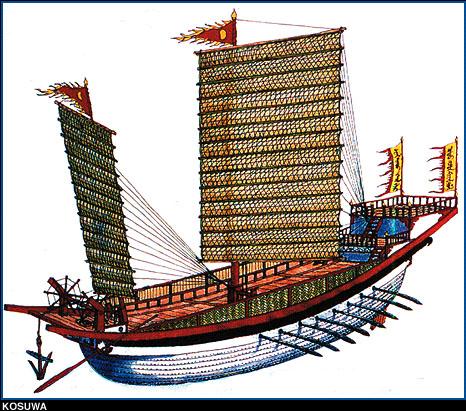J.D. Woodruff, K. Kanamaru, S. Kundu and T.L.Cook
Source -http://geology.gsapubs.org/content/early/2014/12/02/G36209.1.abstract

Illustration, based on contemporary depictions in scrolls and discoveries from excavation of the Takashima shipwreck, depicts a warship from the Mongol invasion fleet. (KOSUWA)
Abstract
In the late 13th century, Kublai Khan, ruler of the Mongol Empire, launched one of the world's largest armadas of its time in an attempt to conquer Japan. Early narratives described the decimation and dispersal of these fleets by the "Kamikaze" of 1274 CE and 1281 CE, a pair of intense typhoons "divinely" sent to protect Japan from invasion. These historical accounts are prone to exaggeration, and significant questions remain regarding the occurrence and true intensity of these legendary typhoons. To provide independent insight, we present a new 2000 yr sedimentary reconstruction of extreme coastal flooding from a coastal lake near the location of the Mongol invasions. Two marine-sourced flood deposits date to the Kamikaze typhoons and are the events of record in the reconstruction. The complete reconstruction indicates periods of greater flood activity relative to modern beginning ca. 250 CE and extending past the timing of the Kamikaze events to 1600 CE. Comparisons with additional reconstructions are consistent with greater regional typhoon activity during the Mongol invasions due to the preferential steering of storms toward Japan, and driven by greater El Niño activity relative to modern. Results are consistent with the paired Kamikaze typhoons being of significant intensity, and support accounts of them playing an important role in preventing the conquering of Japan by Mongol fleets. The Kamikaze typhoons may therefore serve as a prominent example for how past increases in severe weather associated with changing climate have had significant geopolitical impacts.